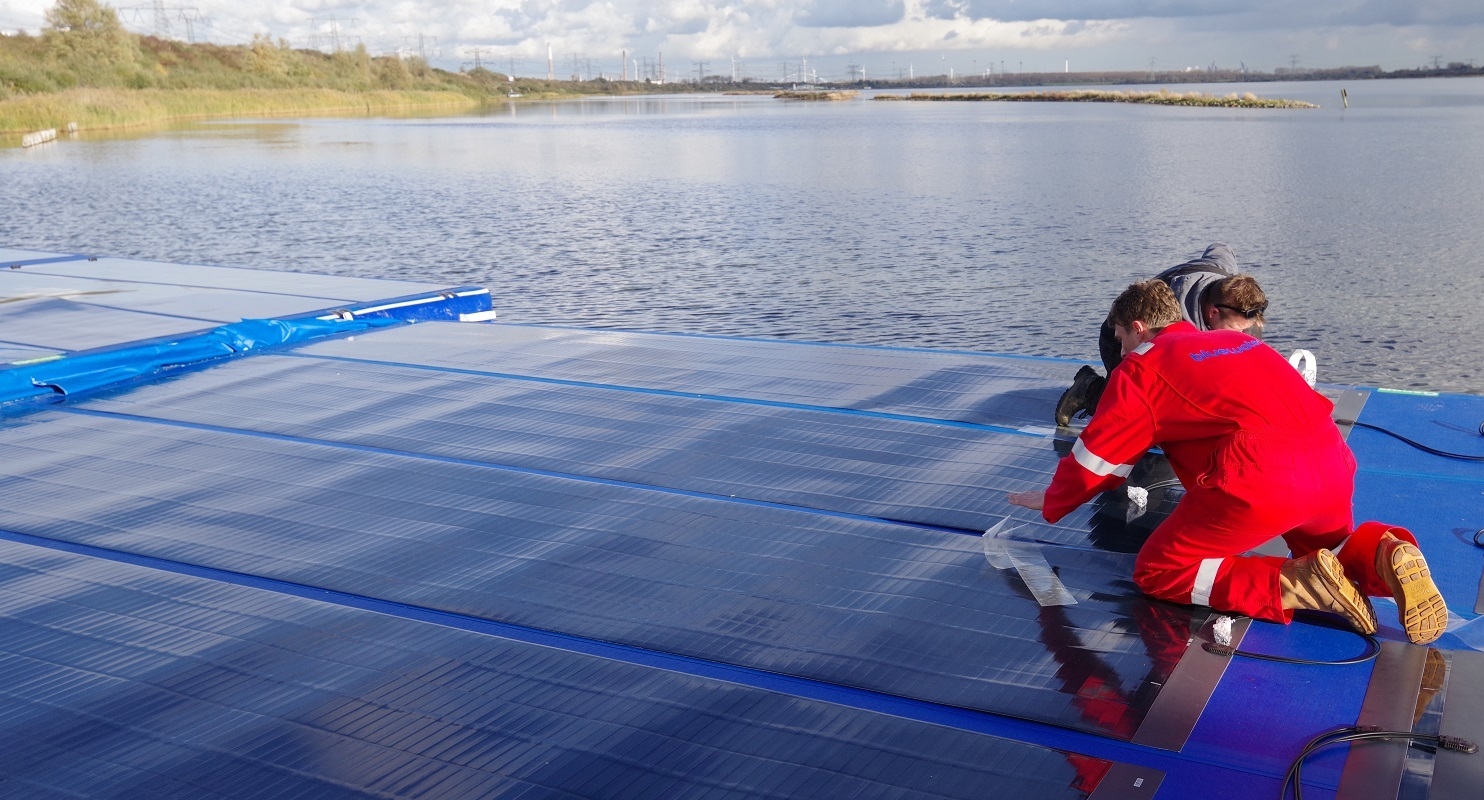
Floating solar
Floating solar will make a significant contribution to the energy transition. Some scenarios predict 200 gigawatt peak (GWp) of solar power in the Netherlands in 2050, 25 GWp of which will be on inland waters and 45 GWp at sea. The knowledge level is still insufficient. For example, on the effect of wind and waves on the performance and lifetime of floating solar energy systems. That is why we are conducting extensive research that fits with our mission to make solar energy applicable to different types of surfaces.
Inland floating solar
In 2017, together with partners from the National Consortium Solar on Water, we conducted a study on the feasibility of solar energy systems on water surfaces with wave category 2, waves until 1 meter high.
This research took place at the Slufter on the Maasvlakte. This pioneering project provided a comprehensive inventory of challenges and potential failure mechanisms in these types of systems.
From 2020, a field lab on the Oostvoornse Meer provides space for various research projects where we collaborate with small and large size companies and colleague research institutes. These projects focus on investigating the performance, reliability, and ecological behavior of innovative floating solar energy systems, under challenging conditions including waves up to 1 meter high and brackish water.
This has resulted already in significant learnings for the system developers in their ambition to develop large-scale, robust designs for future commercial projects.
We are currently collaborating in the European Horizon project SuRE FPV (2024-2027) with an international consortium consisting of research institutes and companies, making floating photovoltaic power plants sustainable, reliable, and efficient. The SuRE project aims to accelerate the acceptance of inland Floating Solar as a mainstream, cost-effective, and environmentally friendly solution to produce renewable energy.
Carbon footprint floating solar energy systems
TNO analyses the carbon footprint of floating solar systems. A recent report was published in the frame of IEA (International Energy Agency) PVPS Task 12.
Floating solar on IJselmeer?
An interesting line of thought is the construction of ring-shaped islands in the IJsselmeer, so-called atolls. This would allow us to create a significant area suitable for floating solar energy systems that can withstand wave category-3 conditions. This approach can go hand in hand with the required nature development (Natura 2000).
A next step is to use the surface of the IJsselmeer for solar energy. The IJsselmeer also has quite a substantial task in terms of nature development. The question is whether the development of new nature in the IJsselmeer region and solar energy can go hand in hand. Do we see opportunities for synergy on a spatial planning, policy, and/or financial level?
Offshore floating solar
A large area in the North Sea has been designated for offshore renewable energy. Initially intended for wind energy, there is also enough space between the wind turbines to generate solar energy. We are collaborating on several projects aimed at developing robust offshore floating solar energy systems that should deliver high yields and long service lives at acceptable costs.
TNO develops standards for monitoring offshore solar energy pilot projects
Offshore solar energy on the North Sea is increasingly gaining attention. Several pilots and demonstration projects are now in development. It is of key importance that we use these pilots and demonstration projects in The Netherlands to build our knowledge about offshore solar. TNO is closely involved with:
- Demonstration project at the CrossWind HKN location, with Oceans of Energy
- NS2 demonstration project at the OTS, with Oceans of Energy
- Merganser demonstration project at the OTS site, with SolarDuck
- Solar@Sea III pilot project at the OTS site with Bluewater Energy Services
In order to build up high quality systematic knowledge about performance and reliability, TNO strives to use the same monitoring approach in all these projects. It is important to monitor the following aspects of the systems:
- Mechanical behaviour of the system and the mechanical stresses and strains experienced by the components such as the PV panels
- Electrical performance of the PV system, its power yield as a functional result of irradiation, temperatures and system movements
- Visual parameters such as fouling
TNO aims to gather these data in a standardized way, using offshore compatible measurement methodologies and sensors. Analysis of such data will lead to a better understanding of the systematic performance aspects that are independent of the precise design choices for the systems.
Whitepaper 'Structural Testing of Offshore Solar Systems and PV Modules by Wave Slamming'
The first floating pontoons from the Oceans of Energy company have now endured storms and high waves at a test site off the coast of Zeeland. The methodology and findings of the experimental test campaign, along with recommendations for the next steps towards certification, informed by the NS2 project results, are now described in a whitepaper.
Projects offshore floating solar
We contribute to these projects from various areas of expertise and labs. Examples include solar energy components (modules and electronics) and complete systems, as well as new measurement methods to examine systems and components.
The first floating pontoons from the Oceans of Energy company have now endured storms and high waves at a test site off the coast of Zeeland. A first step in demonstrating that offshore solar farms continue to function under severe weather conditions.
Among other things, the NS2 consortium, led by Oceans of Energy, has developed and tested a megawatt-scale offshore solar pilot for four years at sea, 12km off the coast of Scheveningen.
Partners are TNO, Deltares, NIOZ, WMR, TKF and Primo Marine. We have investigated the suitability of PV modules for offshore use and the integration aspects of offshore solar energy, including operations and maintenance (O&M) in wind farms.
Within this NS2 project TNO, Oceans of Energy and Deltares conducted a unique full-scale experimental test in a wave flume from Deltares. This study focused on the impact of wave slamming on several floating platforms of Oceans of Energy, aiming to understand specific farm behavior and PV module performance in a controlled environment.
DNV has been invited to share its insights on the process of developing qualification guidelines and certification. The methodology and findings of the experimental test campaign, along with recommendations for the next steps towards certification, informed by the NS2 project results, are now described in a whitepaper (pdf).
Within the Solar@Sea project, Bluewater, Endures, Genap, Marin, TNO and Avans Hogeschool are working together at a concept based on a flexible structure. The basic idea here is to make the structure move optimally with the waves and to apply flexible solar panels. In this way, the consortium hopes to arrive at a robust solution that can withstand the forces of nature and achieves a high yield.
CrossWind, a joint venture of Shell in the Netherlands and Eneco, has realized the offshore wind farm Hollandse Kust (Noord). Together with CrossWind (a joint venture between Shell and Eneco), we have collaborated on demonstrating an offshore solar innovation within the offshore wind farm. Oceans of Energy was selected as the system provider, and an offshore solar demonstrator of 500 kWp is planned to be installed during the summer of 2025.
In the Merganser project, we are collaborating with SolarDuck, Marin, Deltares and TU Delft. The consortium has developed, and tested an offshore solar pilot installation under offshore (North Sea) weather conditions during summer 2024.
The installation consisted of 6 coupled platforms with a total capacity of 500 kWp. Through this project, the consortium had gained more insight into the suitability of the technology to operate under extreme offshore conditions. In addition, the partners have researched the ecological impact of such solar energy systems at sea and the incorporation of solar energy into offshore wind farms.

More about floating solar
Get inspired
Wind energy webinars

Switch to the hybrid energy system


